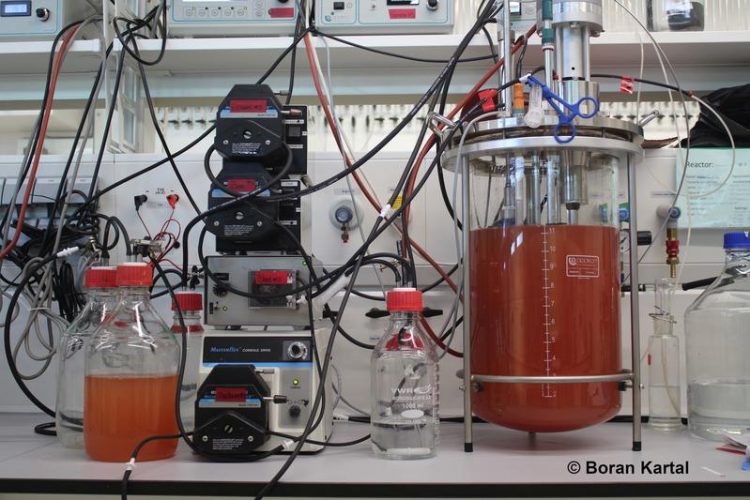Discovery of an unusual protein

One of the bioreactors that Kartal and his colleagues used to grow cells of K. stuttgartiensis in the lab. Boran Kartal
Nitrogen is an essential component of life. For example, it is required for the production of proteins. Boran Kartal, head of the Microbial Physiology group at the Max Planck Institute for Marine Microbiology in Bremen, studies nitrogen-cycling microorganisms, which control the bioavailability of this vital resource.
A particularly interesting part of the nitrogen cycle is the anammox process, short for anaerobic ammonium oxidation. Here, nitrite or nitric oxide and ammonium are converted directly into dinitrogen gas.
Now Kartal and his colleagues discovered a protein involved in the anammox process that might have some surprises. Their results are published in the November issue of Journal of Biological Chemistry.
Too unusual to be noticed up to now
This protein, a heme-containing cytochrome, is involved in the conversion of ammonium and nitric oxide to hydrazine. “Heme proteins have profound functions in life, like hemoglobin in our blood that carries oxygen. Heme structures in general resemble a spider web with an iron atom sitting in its center.
Throughout the tree of life, we can recognize where this spider web binds to the rest of a protein from a pattern typically formed by five amino acids,” Kartal explains. “Surprisingly, the protein we discovered has a very unusual and unexpected structure. It forms this pattern with only four amino acids, and was therefore overlooked in studies up to now.”
Reduction of climate-active gases
The new protein is in the center of a very exciting and relevant process. Anammox bacteria produce only atmospheric nitrogen (N2) from nitrite or nitric oxide (NO) and ammonium, as Kartal previously showed. Unlike many microorganisms, they do not convert nitric oxide to the greenhouse gas nitrous oxide (N2O).
Consequently, each molecule of NO that is transformed into N2 instead of N2O is one less molecule adding to climate change. Anammox bacteria reduce the amount of NO available for N2O production, and therefore, the amount of released greenhouse gas.
A surprisingly common pattern
This relevance in mind, Kartal and his colleagues carried out a database search to investigate how widespread proteins with the newly discovered pattern are in nature. “Remarkably, this pattern is very common,” says Kartal.
Proteins with the four-amino-acid pattern are present in a large variety of microorganisms throughout the bacterial and archaeal domains. “It is found in many different groups of microorganisms such as methanotrophs, that live on methane, and metal degraders,” Kartal continues.
The full potential of proteins with the four-amino-acid pattern is completely unexplored. “In the anammox bacteria, it is found in a protein that shuttles electrons.” Kartal says, “In other organisms this pattern might confer special properties to the proteins it is in. This is definitely something to investigate further.”
Dr. Boran Kartal
Head of the Mi¬cro¬bial Physiology Group
Max Planck Institute for Marine Microbiology,
Bremen, Germany
Phone: +49 421 2028-645
E-Mail: bkartal@mpi-bremen.de
Christina Ferousi, Simon Lindhoud, Eric R. Hester, Joachim Reimann, Frauke Baymann and Boran Kartal: Discovery of a functional, contracted heme-binding motif within a multiheme cytochrome. The Journal of Biological Chemistry, Vol. 294, Issue 45, 16953-16965, November 8, 2019
DOI: 10.1074/jbc.RA119.010568
https://www.mpi-bremen.de/en/Discovery-of-an-unusual-protein.html
Media Contact
All latest news from the category: Life Sciences and Chemistry
Articles and reports from the Life Sciences and chemistry area deal with applied and basic research into modern biology, chemistry and human medicine.
Valuable information can be found on a range of life sciences fields including bacteriology, biochemistry, bionics, bioinformatics, biophysics, biotechnology, genetics, geobotany, human biology, marine biology, microbiology, molecular biology, cellular biology, zoology, bioinorganic chemistry, microchemistry and environmental chemistry.
Newest articles

First-of-its-kind study uses remote sensing to monitor plastic debris in rivers and lakes
Remote sensing creates a cost-effective solution to monitoring plastic pollution. A first-of-its-kind study from researchers at the University of Minnesota Twin Cities shows how remote sensing can help monitor and…

Laser-based artificial neuron mimics nerve cell functions at lightning speed
With a processing speed a billion times faster than nature, chip-based laser neuron could help advance AI tasks such as pattern recognition and sequence prediction. Researchers have developed a laser-based…

Optimising the processing of plastic waste
Just one look in the yellow bin reveals a colourful jumble of different types of plastic. However, the purer and more uniform plastic waste is, the easier it is to…



